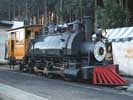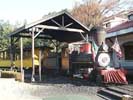

Two American steam engines are quietly spending the rest of their days
at a theme park located in the Nikko area of Tochigi Prefecture, which
is well known for the Nikko National Park with its scenic mountain
views and the historic Toshogu Shrine. The theme park, called the
Western Village, features the pioneering days of the American West. It
is situated in a rustic location surrounded by woods lying at the foot
of Nikko Mountain Range, which is particularly beautiful when covered
with snow in winter.
The two engines are a Baldwin and a Poter. Their names are Waipahu and Virginia.
Waipahu
This engine, built in 1897, came from the Roaring Camp & Big Trees
Narrow Gauge Railroad in California in 1988. It originally worked at a
sugar producing plant on the island of Oahu in Hawaii, where it was
used for hauling sugarcane trains. Since it was operating at the
WAIPAHU complex near Pearl Harbor, it was so named. It was withdrawn
from service after WWII. In 1954, it was purchased by a train
enthusiast in California, and was operated at his Cotton & Wood
Southern Railway. In 1978, it was transferred to the Roaring Camp R.R.
and served as a motive power for excursion trains for close to 10 years
until it crossed the ocean to its new home in the Western Village,
Japan.
The Waipahu then served for five years in its original form after the
park opened. However, as problems due to the effects of age began
requiring major maintenance work, a project to overhaul the engine
commenced in 1993. The project took about five years to be completed,
and involved reproducing most of the components of the equipment. This
required intensive work starting with drawing up plans, then replacing
the boiler with a newly built one, reconstructing the cab, etc. In
fact, engineering work needed almost the same as building a new steam
engine. It finally returned to work in the fall of 1998, with proudly
displaying its beautifully restored figure.
The Waipahu is a three feet gauge engine, 0-6-2 saddle tank. One of its
prominent features is the wheels arranged inside the side frames. The
boiler is saddled with a welded water tank, which supposedly used to
use a riveted one. An air compressor and its associated piping were
added for the pneumatic brake system. A steam turbine-generator was
installed on the top of the tank. The fire room, where firewoods or
sugar grains might be burnt, was modified to an oil-burner.
Nevertheless, it is said that the Waipahu well retains its original
form.
Virginia
The Virginia is a three-foot gauge engine, a 2-4-0 tender built by
Porter in 1926. There is a lack of information about this locomotive,
but it is known that it was working at the Mission Creek 1894 Theme
Park in Minnesota until 1991 before being relocated to this village. It
has the form of a typical American type engine, with a large diamond
stock and a cowcatcher. The appearance of the Virginia is rather simple
in contrast to the Waipahu, because it is not fitted with any extra
components on the exterior; the braking device is only a steam brake.
This engine employs an oil-burner to generate steam.
One day in December 1998, I visited Western Village.
Unfortunately, the Waiphau was not in operation that day. However, I
was invited to the shed and was given an opportunity to photograph the
engine and to talk to the chief engineer, Mr. Iwao Koyama. He works
hard together with his staff to operate and maintain these American
steam engines on his three-foot gauge railroad. The Virginia made a
vivid impression as it steamed along a 700 m endless track, hauling a
coach brought from the Roaring Camp R.R. With the dynamic sounds of the
steam blasts and the steam whistle, I really enjoyed this fascinating
ambient of American steam engines.